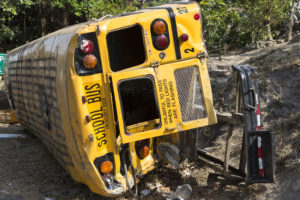School Bus Injuries: What New York Parents Can Expect
School is back in session, and that means more school buses on the road with a higher potential for school bus accidents and injuries. Learn what you can expect if you or your child is injured in a school bus accident.
On August 22, a crash in Cleveland involving a car and a school bus sent 13 elementary school children to the hospital with minor injuries. On August 25, one school bus rear ended another school bus in Bell County, Kentucky, and two children were sent to the hospital with injuries. Earlier this year, 17 children were taken to a New Jersey hospital after a crash that involved two buses. In yet another incident, 16 children and one adult were injured when a school bus collided with a truck. That one happened right here in New York City.
Normally riding a bus is one of the safest travel methods. However, injuries from bus accidents can have long-lasting effects on you and your child. It’s wise to seek both medical attention and a skilled New York bus accident attorney if you are injured in an accident involving a school bus.
Common injuries related to school bus crashes fall into several different categories.
Head injuries
In a bus crash, head injuries most often occur when the head makes impact with the window or with the seat in front of you. They can also occur if flying debris hits your skull.
It’s imperative to seek medical attention for any kind of head injury, no matter how minor. Head injuries can have long-lasting and serious complications, so the importance of a medical exam is high.
Common symptoms of a head injury include headache, blurry vision, insomnia, and nausea. If you experience bleeding, swelling, dizziness, or temporary blackouts, seek emergency medical care.
Doctors will conduct tests for concussions and brain injuries, which can be permanent and life-altering. In a personal injury lawsuit, your medical diagnosis is a crucial piece of evidence which supports your claim.
Soft tissue injuries
Some injuries due to a bus crash may take days or weeks for symptoms to show up. Whiplash is a common injury that occurs in a bus accident. It produces pain in neck muscles, yet it often does not show up right away. You may notice neck tenderness, muscle spasms, and headaches, which can all be related to whiplash.
A doctor can investigate your soft tissue injury and recommend treatment. You can prevent yourself from further injury by seeking medical help.
Back injuries
Damage to the spinal column or vertebrae in a bus crash can be permanently debilitating, depending on the degree of damage.
You must seek immediate medical care to rule out serious injury. Warning signs of a serious back injury are numbness in your extremities or pain in your back or neck after a bus crash.
Abrasions and cuts
Bus crashes may cause cuts, scrapes, and bruises, some serious enough to warrant stitches. During the crash, your body may slam against seating or the bus walls. Flying debris can also wound you. A cup, cell phone, purse, bookbag, book, or accessory can cause significant damage depending on the impact of the crash.
Most abrasions and cuts can be treated with home remedies like ice, bandages, and over-the-counter pain relievers. If you experience lingering pain, or if other symptoms like swelling, oozing, and fever occur, visit the doctor to address any underlying problems.
Injury to extremities
As you are thrown about in a bus crash, you may experience broken bones in your fingers, hands, arms, legs, feet, and toes. You may experience significant injury if the crash impact occurs nearest you or if you are thrown around in the bus during the crash. Seek medical care for severe pain in your extremities, because your bones may not reset correctly on their own and this can lead to further pain.
What to Do If a School Bus Accident Injures Your Child
If you or your child has been injured in a school bus accident, don’t wait to seek out medical care. Not only will this increase your chances of recovering faster and more fully, a medical report is also essential for making a personal injury claim.
Before you file a claim, though, you’ll need an experienced attorney. A knowledgeable lawyer will understand which party will be held responsible for your injuries. Bus accidents are commonly due to negligence on the part of the driver, whether in collisions or rollovers. Victims of school bus accidents must be able to prove negligence in order to receive compensation.
Your first step in a claim? Reach out to a personal injury attorney. A lawyer with a track record of success in school bus accident cases can help you recover your losses due to injury, loss of income, medical expenses, and physical and psychological pain related to the accident.
Holland Tunnel Bus Crash: Reasons Bus Accidents Can Happen
Holland Tunnel Bus Crash: Reasons Bus Accidents Can Happen
Last month, near the New Jersey side of the Holland Tunnel, an unlicensed driver made an improper turn and hit a bus, sending the bus out into an intersection where it crashed into a pole. The bus had 42 passengers aboard, 14 of whom suffered injuries. Luckily all of the injuries were minor in this particular crash. However, often bus crashes result in mass critical injuries – or even fatalities. Worse, bus crashes are on the rise, meaning more people are getting hurt.
If you or someone you love is involved in a bus accident, one of your first questions is probably “Why?” Why did it happen? What caused it to occur? Who is to blame?
There are a number of common causes for bus accidents, and if are facing pain and suffering, medical bills or lost wages as a result of your injuries, you deserve compensation. However, determining liability in a bus crash is typically complex, as there are many reasons for bus accidents and factors that come into play.
Bus company negligence
Fortunately, the MTA is publically operated, so in general it is well-regulated. However, private tour or charter bus companies specializing in longer-distance routes often cut corners on safety regulations, driver training, or vehicle maintenance to maximize profit margins.
Even if it’s not intentional, mistakes happen. When they do, it can lead to catastrophic accidents that result in injury or death of passengers. Under the common carrier law, you may be able to hold the bus company liable for incidents like these.
Bus driver negligence
Many laws or regulations apply to bus drivers including hours of service, maximum bus speed, turning, passing, and others. Drivers are also prohibited from the use of cell phones or from talking to passengers while the bus is moving.
However, these regulations are often disregarded, which can result in accidents. Alternatively, the bus driver may simply be a bad driver, and lapses in judgement can cause accidents. Generally, the bus company is held liable if bus driver negligence results in an accident.
Bus driver fatigue
Driver fatigue caused by overworking, lack of sleep, or sleep apnea, is the leading cause of highway fatalities in the US, and also a leading cause of bus crashes. Sleep apnea is a common cause of driver fatigue, and is more common in transit operators than in the general population.
Another common cause of bus driver fatigue is failure to comply with hours of service regulations, meaning that bus drivers are on the road for too long and become fatigued as a result. If this results in an accident, the bus company can be held liable.
Bad weather
In some cases a bus accident may be caused by inclement weather and bad road conditions, particularly because buses are large and difficult to maneuver. During inclement weather, the bus driver should be properly trained to operate under these conditions and take certain precautions. Further, the transit company should cancel services in the event of very severe inclement weather. Failure to follow these protocols could result in an accident for which the bus company is held liable.
Blind spots
Because buses are very long and windows are often obstructed by passengers, blind spots are a major problem and can cause accidents. However, buses have specialized mirrors to eliminate blind spots when properly adjusted. In the event that mirrors are not properly adjusted and a blind spot is present, the bus company could be held liable for an equipment failure.
Left turns
Left-turn accidents are some of the most common bus accidents. In these cases the driver’s inability to see around temporary blind spots may cause a collision, but drivers are trained to lean forward to avoid these blind spots.
Other drivers
As in the Holland Tunnel bus crash, errors made by other drivers on the road may also cause bus crashes. Distracted or impaired driving on the part of the other driver may also increase the likelihood of a collision.
Bus routes are frequently through urban areas, where lots of other drivers are on the road and the traffic can become incredibly congested. If the other driver is at fault, he or she may be held liable for the injuries of the bus passengers as in a standard auto accident.
Bus fires
Bus fires can be very dangerous, and result in devastating injuries and fatalities. Passengers at the rear of the bus may be unable to escape, or passengers may be overcome by fumes before they can escape.
Bus fires most often arise in the engine compartment, and are usually preventable by proper maintenance. Bus fires less commonly occur in tires and wheel wells, often due to friction from flat or underinflated tires. Bus fires may also occur as the result of a severe accident, when fuel lines are compromised.
If you are involved in a bus accident, to make sure you get the compensation you deserve, it is vital that you consult with a knowledgeable New York personal injury attorney as soon as possible.
This website contains “Attorney Advertising.” It is designed for general information only and should not be construed to be formal legal advice. Prior results cannot and do not guarantee a similar outcome. Please contact us by telephone or email. Be advised that using any method of communication to contact us does not create an attorney – client relationship. In order for this office to represent you, we must enter into a written retainer agreement. Simply contacting us does not create an attorney-client relationship. Please do not send any confidential information to this office until after a signed retainer has been entered into by you and this office.





